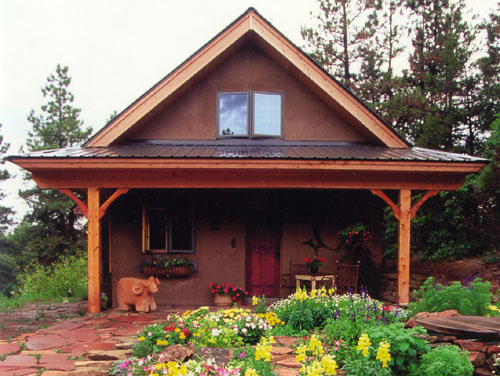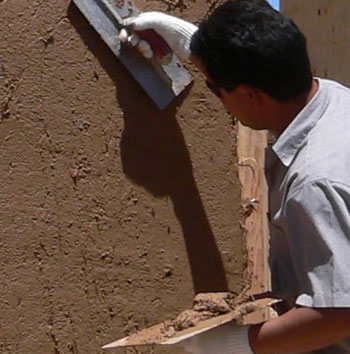I first saw an EcoNest about 9 years ago and had forgotten about them until now. Even after studying many different types of natural building, Econests will continue to be one of my favorites because of their beautiful resemblance to the curves and colors of nature. They might even be the closest way to be outdoors without stepping out the door.

EcoNests are simple, elegant, and healthful handcrafted dwellings that welcome owner participation in their construction. They are the product of a design/build collaboration by Baker-Laporte: Robert Laporte, a timber framer, author, natural house building pioneer and teacher, and Paula Baker-Laporte, an award-winning architect, Bau-Biologist (building biologist), teacher and author specializing in healthy and ecological design. The EcoNest utilizes natural building techniques including: timber framing, light clay/straw walls, earth plastering, and natural, non-toxic finishes throughout.
Most of the EcoNests are a little larger than a tiny house, but the philosophy remains the same: create a healthy sancutary.
The smallest stock plan for an EcoNest is 700 square feet. But Paula said that Baker-Laporte, and their workshop participants, build quite a few “Hummingbirds”. Small studios without a bathroom or kitchen that are about 200 square feet. A Hummingbird can be integrated into a community with other small buildings that contain bathrooms, kitchens and sleeping areas.
EcoNests are built with timber framing and light clay and straw. Unlike standard building methods that employ vapor barriers, clay/straw walls actually breathe. They are weatherproof yet porous, and they allow for the slow transfer of fresh air and moisture much like human skin. The one-foot thick, light clay/straw walls are a unique combination of insulation and thermal mass, keeping the interior cozy and warm in winter and cool in summer.
The light clay/straw walls are then coated with earth plaster. The walls are ideally suited to plaster because they are perfectly flat but coarse in texture so that the plasters adhere to them without needing lathe. Earth plastered walls are both durable and beautiful. The floors of the houses are made of natural materials such as earth and stone.
Econests have been built in many different locations including Portland, the Northeast and Canada. Most of them are primarily in the American Southwest.
Baker-Laporte offers workshops on how to build your own Econest. You can take workshops in timber framing, clay/fiber construction, roofing, natural plasters and finishers, an Econest intensive, or builder training and apprenticeships.
Photos Courtesy of Baker-Laporte and Associates
By Christina Nellemann for the (Tiny House Blog)





That is just gorgeous. Kinda makes me want to tear ours down and start over. Maybe in another life.
Can you tell us more about this? I’d love to find out some additional information.|
What do you mean by “earth” floors?
Clay tiles! Laurie Baker used to make these type of Eco-friendly homes in Kerala, India.
Earthen floors are finely sifted/cleaned dirt and clay, packed hard in multiple layers, smoothed, polished, and then treated with something like linseed or tung oil to make them permanent. Essentially adobe floors coated in a drying oil.
They’re extremely comfortable, and they have a very gentle ‘give’ and a supple texture a lot like leather. If you’ve ever written on a leather topped writing desk, it reminds me of one of them.
They’re a lot more durable than you’d think given the materials, similar to soft pine or linoleum as far as how well they stand up. The nice thing about them is that they’re much much easier to repair if you do bang them up.
I really like the simplicity and style of this home. It is one of the most (if not the most) practical eco-designs I’ve seen. Thanks for posting..
Brillo. Thanks for the wonderful description of earth floors. Yes, there is nothing out there like them. After several coats of oil or even turpentine and acrylic sealant, they shine like tile floors.
Are Econests as well as cob houses save to build in southern California?
These type of homes although quite beautiful might be dangerous in California because of earthquakes…
some here may b intrusted in a HUB by “Ghost”: make a servivel cabin on a shoestring budget
Quite informative n inventive. re
I think Red is referring to this page I found through google: http://hubpages.com/hub/How-To-Build-A-Survival-Cabin-On-A-Shoestring-Budget